Ocean Thermal Energy: Harnessing Marine Resources for Clean and Secure Islands
Despite the deployment of renewables around the world, many islands remain highly dependent on imported fossil fuels. In the Caribbean, only a small percentage of energy comes from renewable sources, even though there is easy access to a largely untapped energy resource – the ocean. Dive into the challenges and opportunities of marine energy for the future of Caribbean energy grids.
Due to its equatorial location, the Caribbean region is blessed with an abundance of natural resources for harvesting energy, most notably abundant solar and wind resources. Nevertheless, penetration of renewable energy in the region has been slow or even absent, with renewables supplying less than 6% of the total electrical energy. With more than 40 million inhabitants and millions of visitors each year, growing demand for energy in this region requires more sustainable solutions.
Marine energy could supply more than the world’s entire electricity demand.
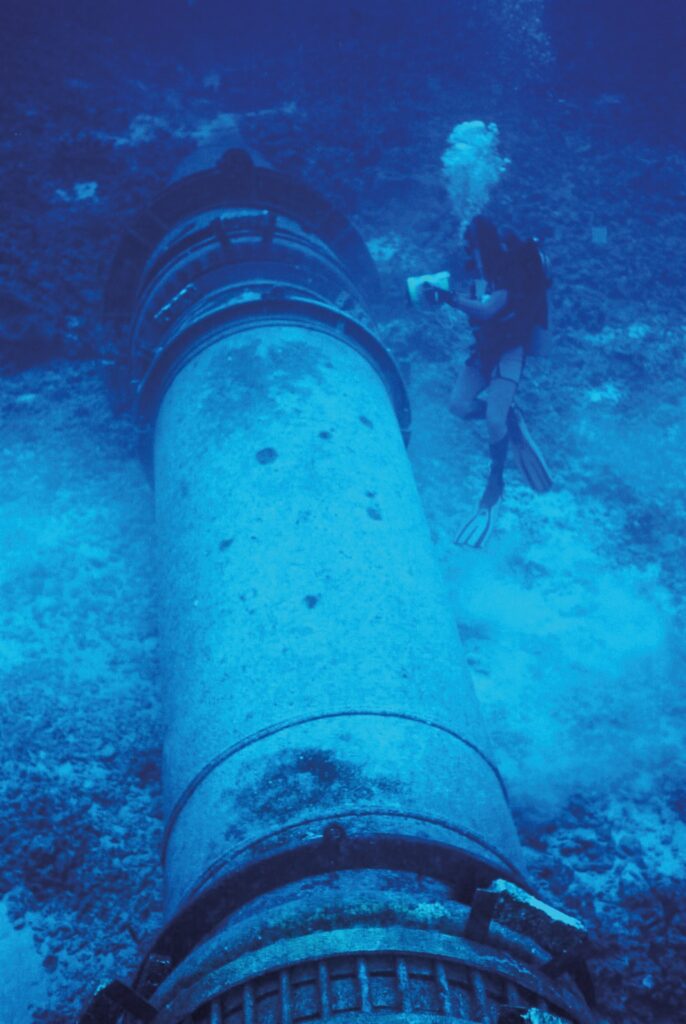
The Caribbean energy market
Despite ambitious renewable energy goals for the upcoming decades, most Caribbean countries are heavily dependent on fossil fuel imports. According to the World Bank, 97.6% percent of all energy generated in the islands came from fossil fuels in 2015. Spot and market energy prices in Caribbean islands are extremely susceptible to volatility associated with international market pricing and the availability of import fuels such as diesel, coal, natural gas, and fuel oil. As a result, Caribbean countries have one of the highest electricity prices in the world. Moreover, this reliance on fossil fuels is contradictory with their overall commitment to protect land and marine environments – their most valuable assets – and one that is severely threatened by climate change. The drop in fossil fuel prices has reduced the burden of imported carbohydrates on public deficits, meaning that shifting towards renewable energy deficits is now seen as less urgent.
What we are left with is a region with a booming tourism industry, an abundance of renewable energy resources waiting to be harvested, energy matrices that are almost exclusively dependent on fossil fuel imports, an overall lack of governmental support, and limited policies to enhance renewable energy. To overcome these challenges, it is time for Caribbean islands to turn to the underdeveloped but most abundant and promising source of energy: the ocean.
Riding the wave
Marine energy could supply more than the world’s entire electricity demand. The global estimated potential for all marine energies – tidal, marine currents, waves, salinity, and thermal forms of energy extraction – is over 24,500 TWh/year. In theory, this means that 50% of the global energy demand could be met with wave energy alone.
50% of the global energy demand could be met with wave energy alone.
Whereas kinetic forms of marine energy, such as wave and tidal power, have enormous potential in open seas at higher latitudes, ocean thermal energy finds most of its untapped potential closer to the equator. The excellent bathymetric conditions (submarine topography) and high thermal differentials exceeding 20°C provide excellent conditions for technically and economically viable ocean thermal energy projects. The Caribbean is one of the most promising regions for ocean thermal technology deployment – along with by south-east Asia – where several Ocean Thermal Energy Conversion (OTEC) and Sea Water Air Conditioning (SWAC) projects are currently at various development stages.
OTEC harnesses the temperature differential between cold, deep ocean water and warm, tropical surface waters to produce electricity. According to the World Energy Council, the resource potential for OTEC is much larger than that of other ocean energy solutions. Around 100 countries could tap into this potential. While OTEC technology is still under development, several prefeasibility studies for the applicability of OTEC in the Caribbean show promising results. OTEC is a stable and secure power that can be operated around the clock and would be easier to integrate into current electricity networks than intermittent renewables such as wind or solar, especially as island networks were not designed to cope with large quantities of intermittent renewables. OTEC is therefore a comparatively more advantageous renewable energy option for islands, as limited transmission and distribution grid investments are required.
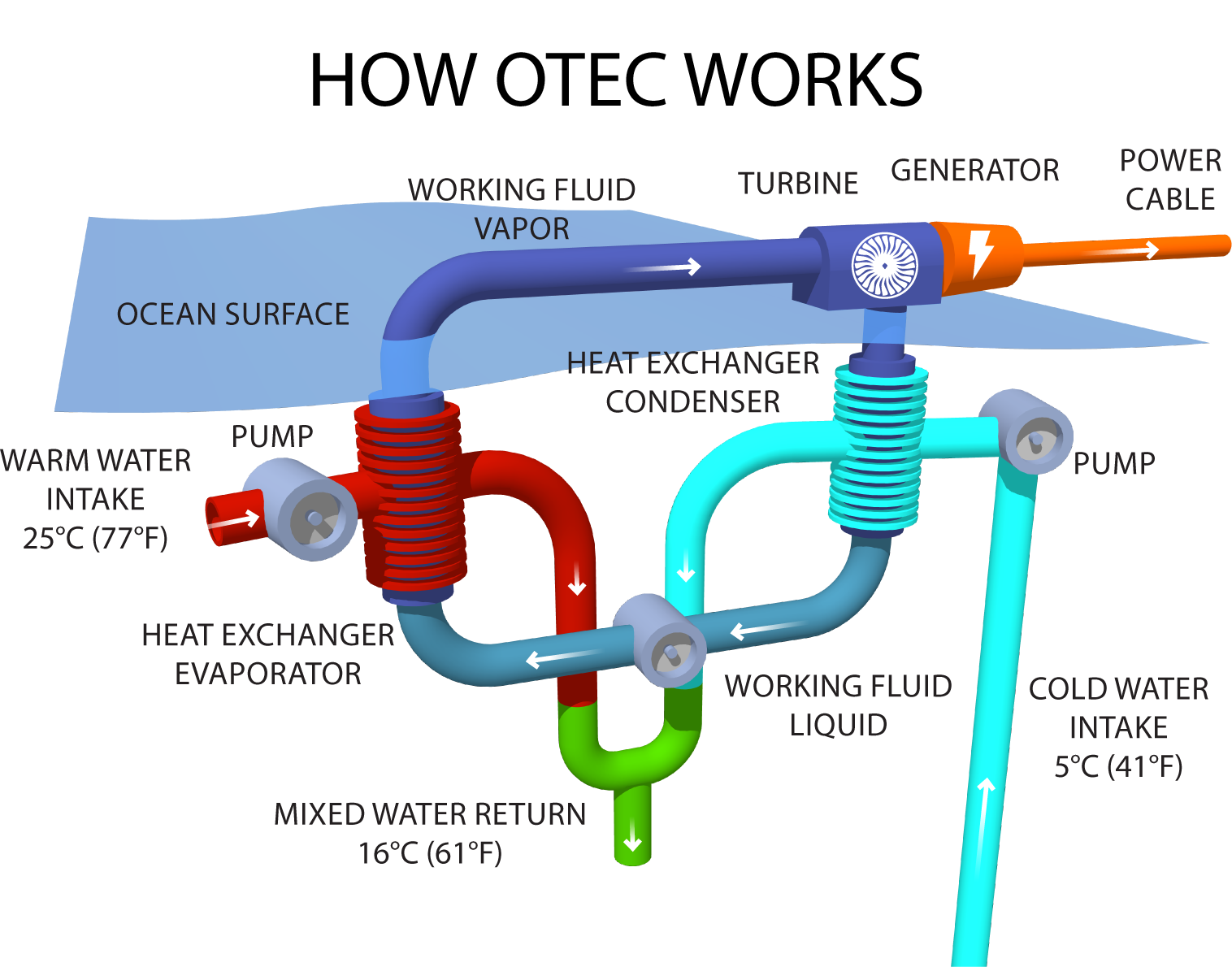
The OTEC Process
A closed-cycle OTEC process is similar to standard refrigeration cycles. Warm seawater passes through an evaporator, which vaporizes the working fluid. The vapor then enters a turbine that turns a generator, producing electricity. The low pressure working fluid enters a condenser where it is then cooled with deep sea water. The working fluid is then reused to repeat the cycle.
The economics of OTEC are unclear as OTEC systems have not been widely deployed yet. However, a study in 2015 by Ocean Energy Systems – an International Energy Agency Initiative – estimated that the first commercial scale OTEC projects could have a cost of energy (LCOE) ranging between $150-280 per MWh. A study by the Worldwatch Institute estimated the LCOE for tidal power at between $210-280, and $40-160 for onshore wind as of 2013. OTEC energy can be competitive with marine and other renewable energies but OTEC technology would need to benefit from a tax and subsidy support scheme similar to competing energy sources. While OTEC may still need to undergo extensive R&D to achieve its promise, SWAC is already a commercially-viable technology that also exploits the marine thermal gradient, albeit with a different purpose.
The SWAC System
In a SWAC system, the marine thermal gradient is used to produce low-cost sustainable air conditioning for buildings or urban areas close to shore. Akin to an OTEC system, a pump brings cold water via a pipe system to an onshore heat exchange station where it absorbs heat from a water loop that the buildings use to power their AC. The seawater then removes heat from the building before being poured back into the ocean.
A study released by CAF (the Development Bank of Latin America) found that SWAC could be an economically-viable option to provide air conditioning to a series of hotel resorts and large public buildings in locations such as Montego Bay in Jamaica or Puerto Plata in the Dominican Republic. In both cases, it is estimated that costs would fall between 34-48% less than conventional air conditioning. Similar results may be expected in other Caribbean sites with sizable cooling loads and favorable bathymetric sites. Currently, HINICIO, Makai Ocean Engineering, and DCNS are analyzing further potential sites for SWAC installations in locations in Panama, the Dominican Republic, and Colombia.
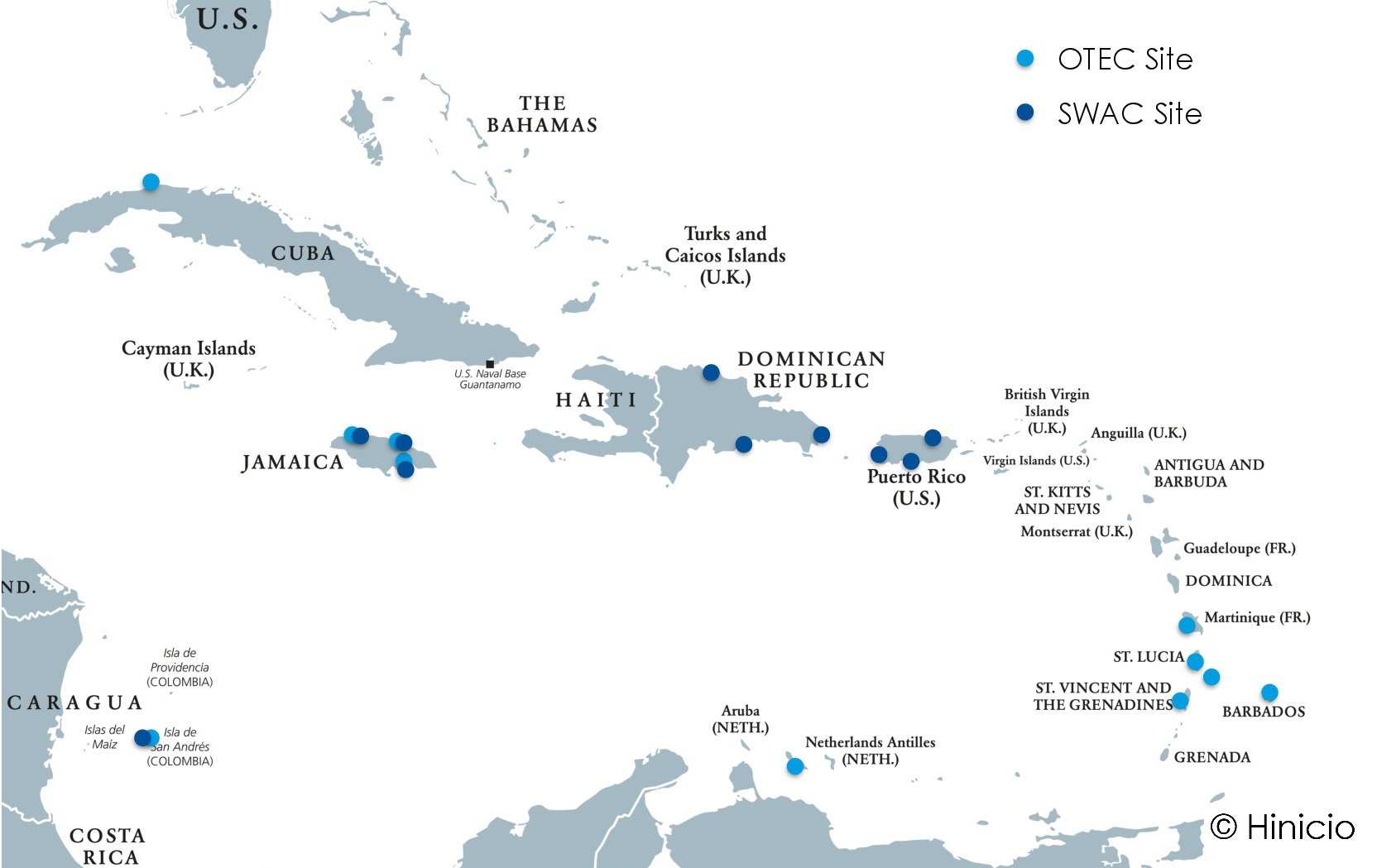
Promising prospects in the Caribbean
Since the 1970s, SWAC and OTEC technologies have been under development with several existing demonstration and pre-commercial projects. Project developers across the marine energy value chain have chosen mostly Caribbean locations to develop the first demonstration OTEC and SWAC projects. Aside from the tremendous energy challenges that the Caribbean islands face in their struggle to wean off fossil fuels, these sites’ bathymetric conditions are highly favorable for both OTEC and SWAC. The “smooth” slopes of the ocean floor and relatively short distances to a significant thermal difference between the upper and lower layers of the ocean provide the ideal circumstances. Most importantly, there is a large concentration of hotel resorts on the Caribbean coastline with significant continual energy and cooling demands. Most resorts are located within 5km from the sea, offering optimal conditions for SWAC and OTEC.
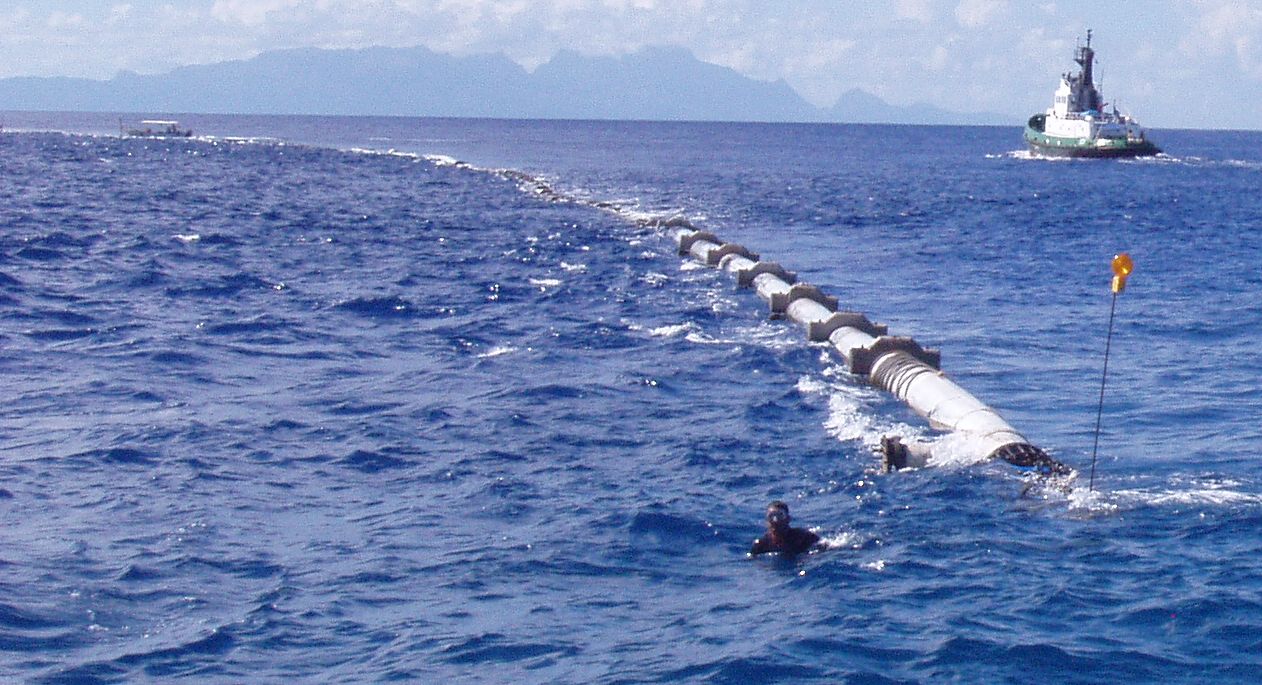
Notable locations with ongoing OTEC projects include the Bahamas, Japan, Martinique, Hawaii, Bora Bora, Reunion island, Grand Cayman, and Curacao. SWAC projects have been implemented in Toronto, Halifax, Hawaii, Stockholm, New York, Bora Bora, Bahamas, and Curacao. A study by HINICIO highlighted the top 10 locations for both OTEC and SWAC in the Caribbean region and South America. Jamaica was judged the best location for SWAC operations, and Santa Lucia for OTEC. This study covered 67 cities in Latin America. Their estimated cooling load, bathymetric conditions, attendant ocean temperatures, and the resulting estimated CAPEX, OPEX, and levelized cooling costs were compared. Pre-feasibility studies by Makai Ocean Engineering in Puerto Plata, Montego Bay, and Santa Marta have shown interesting returns on investment for SWAC. Several pilot projects for hotels and resorts in the Caribbean show that the technology is on the rise.
OTEC energy can be competitive with marine and other renewable energies.
In the years 2010-2015, most Caribbean islands have set renewable energy goals and roadmaps for the next decades but most countries lag far behind their stated objectives. Nevertheless, countries like Jamaica, Barbados, Aruba, and the French islands of Guadeloupe and Martinique have all made remarkable progress. The Bahamas, Jamaica, Grenada, Barbados, and the Cayman Islands are all aiming for a renewable energy penetration above 30% in the next decade. Today all of these islands are virtually 100% dependent on fuel imports, but also have several interesting locations for SWAC and OTEC deployment. This demonstrates that the Caribbean is a promising market for developers who should start working on financing sustainable marine energy projects.
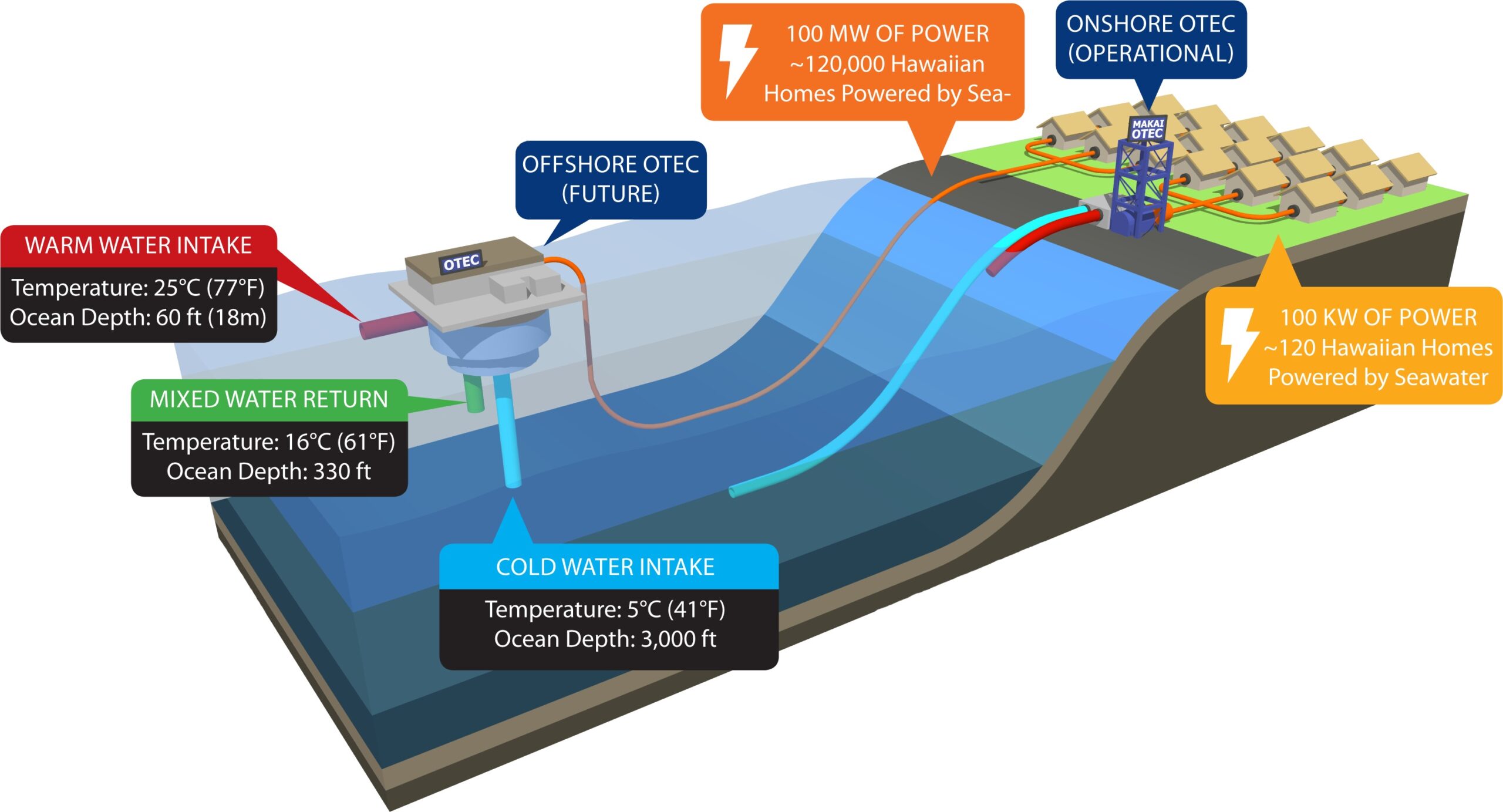
Many challenges remain: energy monopolies, the lack of policy support and leadership, weak public finances and access to commercial financing, lack of technical expertise and assessments of marine energy potential, as well as political pressures exerted by oil exporters pertaining to existing agreements (such as Petrocaribe) which maintain the status quo. However, the excellent conditions for marine energy, promising OTEC and SWAC projects, and a new generation of emerging political leaders aware of climate change and sustainability are promising prospects for the development of marine energies in the Caribbean. At the end of the day, the ocean will do what it does best: The rising tide will come in and wash away all stakeholder doubts about the potential of marine energy in the Caribbean. Harnessing energy from the seas will bring Caribbean islands one step closer to being self-sufficient as they overcome one of the greatest challenges today: achieving energy independence.
Q&A with Jose Andres, President and CEO of Makai
How can SWAC and OTEC technologies become more integrated in the Caribbean?
SWAC systems are a fundamentally different technology than OTEC. SWAC is a proven and commercially-robust technology, while OTEC still requires development and large-scale validation before being proven as commercially viable. Since SWAC is more mature than OTEC and its application to the Caribbean is more likely in the short-term, I will focus on SWAC for this interview.
SWAC involves a district cooling system with a network of underground pipes supplying chilled water to buildings in a coastal area. The technology is simple yet relatively unknown, so educating stakeholders on the benefits of SWAC is key. Successful project execution requires buy-in from all stakeholders, including governments, regulating authorities, customers, the community at-large, and investors. This means that the single most important factor in project success is having a strong local champion capable of financing and developing large energy projects ($25 million to $250 million). Each Caribbean island community has a unique constellation of government and private sector actors, and understanding how to build a project in that specific environment is paramount. Thus, the primary challenges for SWAC are associated with project development rather than technology risks.
Are SWAC and OTEC key technologies in the energy transition for Caribbean islands?
Yes – especially SWAC. OTEC is promising over the next decade, but SWAC can make a real difference today. Areas with high population density and air conditioning loads that are near the shoreline – especially tourist areas with multiple hotels – are good candidates. SWAC can reduce energy consumed for cooling by up to 90%, which can result in huge cost savings of millions of dollars annually while decreasing the strain to the local electrical grid. SWAC also reduces environmental footprints by eliminating the evaporative water and sewer usage required for conventional AC.
What can be done to enable a future powered by ocean thermal energy?
The industry needs a successful project in the Caribbean to serve as a model for the rest of the region. However, the early-stage money to study feasibility and cost for a project are at-risk dollars. The studies funded by CAF (Development Bank of Latin America) and others go a long way towards reducing that early-stage risk. Once a single successful project is built in the region, I am certain you will see many more projects following suit.